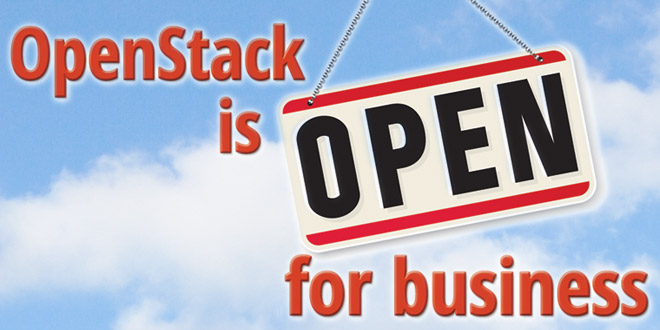
Four years have passed since the project to create an open-source IT stack began between NASA and Rackspace. Two years have passed since the creation of the OpenStack Foundation, the governing body behind the large ecosystem of open-source projects that make up OpenStack. The here and now of OpenStack resembles much of what was promised early on: Large vendors like HP, Red Hat, IBM and Mirantis are offering their own supported distributions of the platform.
Those big companies are turning OpenStack into private cloud-management products, said Lauren Nelson, senior analyst at Forrester Research. “There are private cloud suites that have management tools, which have OpenStack sitting beneath the product, but you would not know it was there.”
She cited IBM SmartCloud and HP Cloud Service Automation (CSA) as one solution with another being “HP Helion as a pure distribution.” These are the types of products she points to for enterprise adoption of OpenStack because, she added, “It is difficult for enterprises to adopt [plain OpenStack]. More commonly, they’re using the full private cloud suite.”
(Related: How OpenStack became more cohesive)
In order to discuss this phenomenon further, however, the terms must be closely defined. “OpenStack is primarily just a cloud platform,” said Nelson. “It looks like what’s exposed to a public cloud user. I call that a platform. That can sit beneath a private cloud suite.” She coined the term “private cloud suite” to mean the combination of something like OpenStack with higher-level cloud-management tools like CA’s Opscenter or Cisco’s Intelligent Automation for Cloud.
That leaves OpenStack as the nuts and bolts for large enterprise cloud-management suites. And in this regard, the platform has come to compete with VMware’s offerings. “If you look at most private cloud suites today, they have this ability to plug in whatever [underlying platform the enterprise has]. That could be vCloud automation center, that could be a public cloud platform,” said Nelson.
That’s good news for companies looking at OpenStack as the future of their internal cloud platforms. “In terms of platforms that exist today, it’s standardized on OpenStack,” said Nelson. “[Apache] CloudStack is still out there, but it’s decreasing in numbers. There’s also vCloud Director or vCloud Automation Center. More commonly we see [VMware’s] vSphere being used for some of its basic capabilities.”
Thus, in four years, OpenStack has become the de facto open-source standard for internal cloud platform infrastructure, not unlike how Unix and then Linux became the common platform between the large enterprise vendors. HP and IBM went from having their own platforms, to having their own Unixes, to having their own Linuxes (sort of), to now having their own OpenStack-based cloud-management suites.
That’s not to say you can’t just buy OpenStack from a hot young company still defining the market. Much in the way Red Hat came to mean Linux, Mirantis has come to mean OpenStack. And yet, the two companies are now directly competing, each with its own enterprise distribution.
All this competition is great for the enterprise manager who has to make a choice. But even before picking a distribution, the underlying projects that make up OpenStack offer compelling uses on their own. No matter which distribution you choose, your options when it comes to storage, networking and processing are expanding every day with projects like Gluster, Ceph and Quantum, confirming the IT department wins on what was considered young, unproven software only two or three years ago.
Distribution solutions
Though OpenStack is finally available to enterprises with corporate support and updates, it remains a complex beast that brings an entirely new paradigm into the data center. Radhesh Balakrishnan, general manager of virtualization and OpenStack at Red Hat, said that OpenStack is not just a replacement for old systems; it fundamentally rewrites the way a data center runs.
“The reality is, in terms of pure technical scope, the nature of the problem set here is broader by definition,” he said. “The fundamental fabric of the data center is being stitched together in a new way. It’s a function of the scope that you can see some progress. From our perspective, the adoption of OpenStack is going to be tightly tied to cloud computing and the new application architecture itself.”
Adrian Ionel, CEO of Mirantis, said that while OpenStack changes how the data center runs, it isn’t entirely different from existing large enterprise software products in that it’s a big project to install, run and configure the platform, just as it is to install an ERP or new database layer. That’s not to say, however, that OpenStack hasn’t made things easier.
“OpenStack has come a very, very long way,” said Ionel. “The power of OpenStack is, at the same time, the curse of OpenStack. The power is that it’s incredibly flexible, so you can tailor it in many different ways. That requires a tremendous level of expertise in terms of what knobs to turn. It’s extremely configurable; it has hundreds and hundreds of configuration settings. Only some of them are resolved in robust production-grade deployments.”
As a result, OpenStack anything will be complicated. There’s no such thing as a one-click deployment, said Ionel, though he did point out that Mirantis offers a simple, graphical installer for OpenStack. The result of this complexity is that distributions aren’t necessarily to be judged by their pretty installers alone.
Imad Sousou is vice president of the Software and Services Group at Intel and general manager of the Intel Open Source Technology Center. He is also a gold-level director of the OpenStack Foundation. He said that OpenStack “has improved tremendously from a couple years ago. Two things happened at the same time: One is the maturity of OpenStack itself, but the second part is you have reasonably good distributions now.
“OpenStack is still a work in progress, and I think the areas of deployability and support and things like that, right now, are still evolving,” said Sousou. “I think it’s still [difficult] unless you have decent and strong engineering resources to actually deploy it and maintain it and so on. A year ago, it wasn’t possible to deploy without those type of resources.”
What’s most important in a distribution, said Ionel, is the stability of its components. “OpenStack—that is, the upstream community—doesn’t test OpenStack very hard,” he said. “It’s not their mission. They are not to blame. They do some basic testing that is not relevant to production use.
“We at Mirantis have been aware of this for some time. We know these challenges, which is why Mirantis OpenStack works extremely well out of the box [and] is easy to set up and configure. It’s like configuring your car on the Web: You have a beautiful orchestrator, you push a button, and 30 minutes later your cloud that’s production-worthy will be up and running.”
Tim Yeaton, senior vice president of infrastructure at Red Hat, said that open-source “communities, in general, are organized around driving innovation. For mission-critical deployments, there needs to be someone like Red Hat to take that and make it stable and give it a life cycle. Gartner was complaining about robustness of upstream [OpenStack] technologies from a supportability standpoint. It’s going to get better, but it’ll always be innovation first.”
Umbrella of projects
Indeed, OpenStack has become the place for innovative cloud services to start and grow. Outside of OpenStack, many in-cloud service companies, such as Eucalyptus and Nimbula, long ago gave up on their efforts to spread Amazon Web Services-like APIs into private clouds. Instead of replicating Amazon, OpenStack has become the place where innovative new services are being tested—services like Red Hat’s storage services, Gluster, Ceph, and Project Neutron (formerly known as Project Quantum). Gluster is a multi-petabyte distributed file system that can be used to host numerous types of workloads. Ceph is a combination object, block and file storage system that has been in the works for almost 10 years now. And Neutron was originally the work of a software-defined networking company, Nicira. Neutron allows OpenStack clouds to define their own networking topology.
Underneath all of these sub-projects, however, is still a somewhat nebulous core that makes up OpenStack. Sousou said that he has been pushing for a more defined core of the platform from his post in the OpenStack Foundation.
“What we are working on at the board level in the Foundation is to define the core,” he said. “What does it mean when you say OpenStack? It’s quite a large number of projects, and not all of them you’d consider core.”
Sousou added that the goal is to define the core so that distributions can be evaluated and “you can put an OpenStack sticker on it.” That’s important if multiple distributions are going to coexist in the marketplace. If different versions of OpenStack are not compatible with one another, the whole allure of OpenStack is lost.
“Having consistent APIs and stable APIs for the core is actually really important,” said Sousou. “There are quite a few open-source projects that overlap with OpenStack. That’s great, but it needs to be defined what constitutes core OpenStack so everybody understands how they can add capabilities in a way that’s similar to Linux.”
Ionel said that Mirantis is heavily focused on evolving and stabilizing the core of OpenStack. “We have such a deep footprint all over the core projects. We do have a huge emphasis on networking because we see networking as the fundamental glue that keeps the entire cloud together and is the biggest influence on reliability performance and scalability,” he said.
“Another very big emphasis we have is at the application-management layer on top of OpenStack. Virtually all of our customers buy OpenStack not for the sake of OpenStack; they’re buying it to develop and run applications on top. They want to make it as accessible as possible for developers. We have a huge opportunity there; a tremendous amount of value can be created.”
Work to be done
The future of OpenStack is bright, but it is not without the flashing lights of construction crews.
Sousou said that OpenStack needs particular focus on becoming more enterprise-ready. “One of the initiatives we at Intel started in OpenStack six months ago is the enterprise initiative at OpenStack. It revolves around the questions of how do you make OpenStack enterprise ready—things like high availability and manageability, security and compliance,” he said.
“It’s not really one thing; it’s a whole bunch of things. I think it’s just a matter of time until it gets there. In general, I think things are going in the right direction, but I don’t think it’s done. The core savvy enterprises will be able to deploy it, but for mass deployments in enterprises, OpenStack still needs work, and everybody is still doing the work.”
That’s echoed by Nelson, who said that many early adopters were left behind when OpenStack upgrades were released. “The upgrade path is not easy. I think a lot of people that adopted OpenStack early on realized it’s immature, and updates come every couple months, and if you put customer code into it you’ll be stuck when it’s time to upgrade,” she said.
Ionel is convinced that OpenStack is the technology that can drive enterprises to success in the coming years. “OpenStack absolutely can become the Android of the cloud data center. It plays the same role in the data center space that Android is playing in the mobile space,” he said.
“That’s the opportunity here; we see accelerating traction for that. We think more and more of the best brands in the world are the companies that have the largest infrastructures, the deepest pockets, and who make commitments to OpenStack.”
Red Hat’s Balakrishnan sees the future of OpenStack moving in a slightly different direction. “Eighteen months ago, OpenStack was viewed as this Play-Doh: How do we shape this to fill our needs?” he said. “That’s where storage and PaaS come in as excellent end destinations we can create. Storage, because on the public cloud side, the top three players make more than 40% of their revenue on storage, compliance, etc. Storage becomes the first use case that you don’t have to spend a lot to justify the business case. That’s why we’re very very excited about Ceph being one of the killer apps for OpenStack.”






